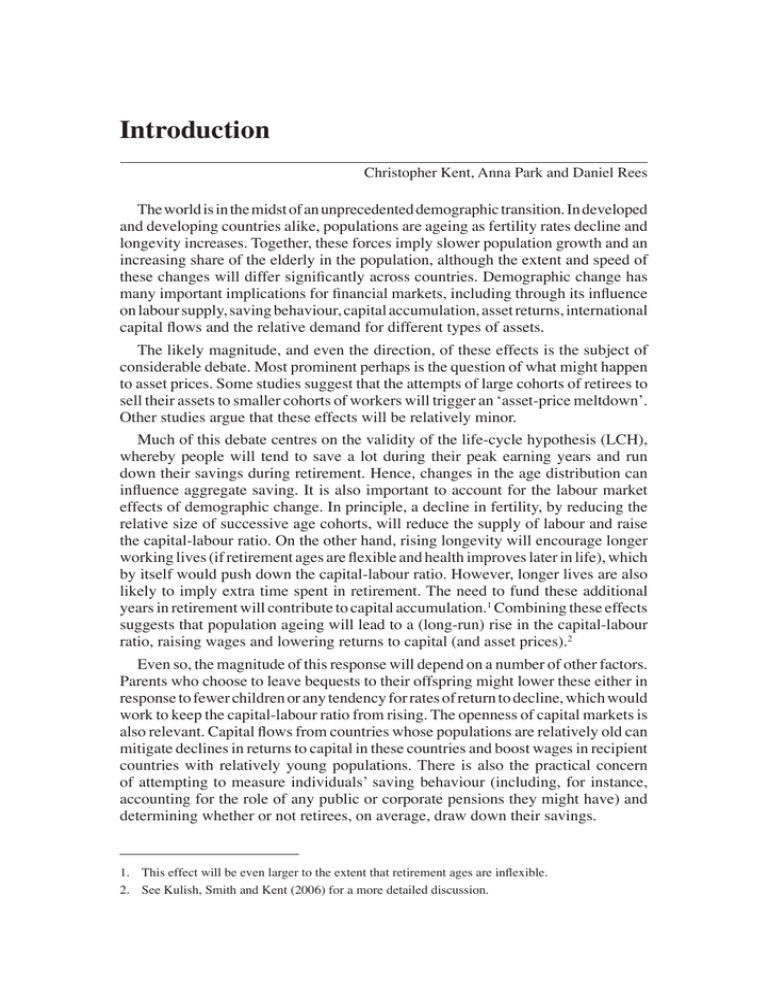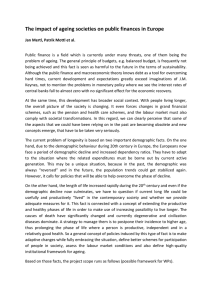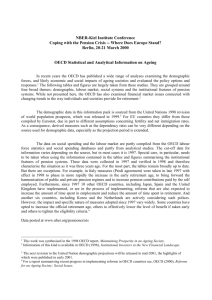Introduction
advertisement

Introduction 1 Introduction Christopher Kent, Anna Park and Daniel Rees The world is in the midst of an unprecedented demographic transition. In developed and developing countries alike, populations are ageing as fertility rates decline and longevity increases. Together, these forces imply slower population growth and an increasing share of the elderly in the population, although the extent and speed of these changes will differ significantly across countries. Demographic change has many important implications for financial markets, including through its influence on labour supply, saving behaviour, capital accumulation, asset returns, international capital flows and the relative demand for different types of assets. The likely magnitude, and even the direction, of these effects is the subject of considerable debate. Most prominent perhaps is the question of what might happen to asset prices. Some studies suggest that the attempts of large cohorts of retirees to sell their assets to smaller cohorts of workers will trigger an ‘asset-price meltdown’. Other studies argue that these effects will be relatively minor. Much of this debate centres on the validity of the life-cycle hypothesis (LCH), whereby people will tend to save a lot during their peak earning years and run down their savings during retirement. Hence, changes in the age distribution can influence aggregate saving. It is also important to account for the labour market effects of demographic change. In principle, a decline in fertility, by reducing the relative size of successive age cohorts, will reduce the supply of labour and raise the capital-labour ratio. On the other hand, rising longevity will encourage longer working lives (if retirement ages are flexible and health improves later in life), which by itself would push down the capital-labour ratio. However, longer lives are also likely to imply extra time spent in retirement. The need to fund these additional years in retirement will contribute to capital accumulation.1 Combining these effects suggests that population ageing will lead to a (long-run) rise in the capital-labour ratio, raising wages and lowering returns to capital (and asset prices).2 Even so, the magnitude of this response will depend on a number of other factors. Parents who choose to leave bequests to their offspring might lower these either in response to fewer children or any tendency for rates of return to decline, which would work to keep the capital-labour ratio from rising. The openness of capital markets is also relevant. Capital flows from countries whose populations are relatively old can mitigate declines in returns to capital in these countries and boost wages in recipient countries with relatively young populations. There is also the practical concern of attempting to measure individuals’ saving behaviour (including, for instance, accounting for the role of any public or corporate pensions they might have) and determining whether or not retirees, on average, draw down their savings. 1. This effect will be even larger to the extent that retirement ages are inflexible. 2. See Kulish, Smith and Kent (2006) for a more detailed discussion. 2 Christopher Kent, Anna Park and Daniel Rees This discussion, however, does not directly address whether there is a need for policy-makers to respond to demographic change. The scope for this will depend on the existence of market failures preventing first-best outcomes. Such failures typically arise because of a lack of information or non-rational behaviour of individuals, but can also reflect the unintended consequences of existing policies.3 Policy actions could take many forms, from the fairly unobtrusive – such as the collection and dissemination of information to help markets determine appropriate pricing for financial products – to the more interventionist – such as issuing public securities to create markets, or mandating individuals’ participation in certain retirement income schemes. This workshop, jointly hosted by the Australian Treasury and the Reserve Bank of Australia, continues the Group of Twenty’s focus over recent years on demographic change.4 Its aim was to bring together leading academic researchers in the field, financial market participants and policy advisors from the G-20 countries to consider questions relevant to demography and financial markets. What can theory and historical experience tell us about the impact of demographic change on financial markets? And what are the implications for policy-makers? This introduction summarises the papers presented at the workshop and the discussions that accompanied them. Trends in Demography and their Economic Impacts The first paper, presented by David Bloom (and co-authored by David Canning), summarises projected global demographic trends, analysing the role of greater longevity and declining fertility in driving population growth and ageing. Their main points are that the world’s population will continue to grow, albeit at a slower rate, and that population ageing is a global phenomenon, but with considerable variation in its extent and timing across countries. Developed countries, where the process is well advanced, will experience negligible population growth and will see rapid increases in the number of retirees relative to working-age populations over the next few decades. In contrast, the populations of developing countries overall are still growing relatively rapidly and the share of their populations of 3. For a discussion of informational problems see Barr and Diamond (2006). Mitchell and Utkus (2003) provide a summary of the relevant behavioural economics literature, including evidence that individuals are far from the rational beings implied by many simple models. 4. The members of the G-20 are the Finance Ministers and Central Bank Governors of 19 countries: Argentina, Australia, Brazil, Canada, China, France, Germany, India, Indonesia, Italy, Japan, Mexico, Russia, Saudi Arabia, South Africa, South Korea, Turkey, the United Kingdom and the United States of America. The European Union is also a member, represented by the rotating Council Presidency and the European Central Bank. The Managing Director of the International Monetary Fund (IMF) and the President of the World Bank, plus the chairs of the International Monetary and Financial Committee and Development Committee of the IMF and World Bank, also participate in G-20 meetings on an ex-officio basis. Demography has already been a subject of several G-20 workshops. Under the German chair in 2004, the French Ministry of Finance hosted a workshop on demography and growth. Under the Chinese chair in 2005, the Australian Treasury and the Reserve Bank of Australia hosted a workshop on demographic challenges and migration. Introduction 3 working age will increase until roughly 2030. However, developing countries are also experiencing population ageing; it is not a phenomenon confined solely to the developed world. The paper also considers some of the likely macroeconomic effects of changes in a population’s rate of growth and age structure. The authors note that simplistic arguments that the demographic transition is purely good or bad for the economy have been replaced by more nuanced theories that stress the importance of policy and institutional environments. In particular, good health and education systems, effective labour-market institutions, trade openness and sensible retirement policies will all help to ensure that countries reap the benefits of demographic changes. Bloom and Canning also summarise the (still inconclusive) debate about whether there is a biological limit to longevity and what this might be, and outline some risks to the population projections they present. They conclude that although demographic trends have considerable momentum, they are still inherently uncertain, so policy-makers should design institutions that are robust to a range of demographic outcomes. What Can Theory Tell Us? Four papers examine the potential effects of population ageing by means of theoretical models. The first of these, by Henning Bohn, takes a close look at how demographic change will affect financial markets through its effect on capital intensity (that is, the capital-labour ratio). Bohn considers responses to population ageing using three different closed-economy models: a Solow-Swan growth model with a fixed saving rate; an overlapping generations (OLG) model with individuals maximising their own utility over their life-cycle; and a dynastic model in which individuals also value their children’s utility. In the first two models, population ageing increases the capital intensity of the economy thereby pushing down the rate of return to capital. But in a dynastic setting, any tendency for the rate of return to decline would prompt parents to reduce bequests since they would be better off consuming extra wealth rather than passing it on to their children. This would ensure a relatively stable capital-labour ratio in the presence of demographic changes. Bohn argues that in many developing countries, the dynastic model will provide the better approximation of future patterns of saving and capital accumulation because public pension and other transfer systems in these countries are more rudimentary, and most wealth is concentrated in family-based firms where ownership tends to be inherited and not purchased. However, where financial markets make it possible for retirees to mobilise their accumulated wealth for consumption purposes relatively efficiently, the LCH appears to provide a reasonable guide to future saving patterns. The three other theoretical papers presented use calibrated OLG models to examine the potential for international capital flows to moderate the effects of demographic change. Ralph Bryant’s paper explores how macroeconomic variables, including international capital and trade flows as well as exchange rates, might evolve in response to differences in the demographic transition across two regions – the developed and developing economies. He constructs a two-economy OLG model in which capital gradually flows across international borders in response to differences 4 Christopher Kent, Anna Park and Daniel Rees in returns. Bryant shows that the effects of demographic change will depend on whether declining fertility or increasing longevity is the most significant cause of population ageing, and that the short-run effects of demographic change will differ from the long-run effects. In line with standard OLG results, Bryant posits a longterm rise in capital intensities globally (and hence a decline in returns to capital), but with differences across countries due to ageing occurring at different rates. An especially interesting outcome of this exercise relates to the size and direction of future capital flows. Bryant argues that the faster pace of ageing in developing countries will reduce the net capital flows (relative to output) from developed to developing countries (although he expects developed countries to remain capital exporters for the foreseeable future). This challenges the widely held view that savers in developed countries will be able to avoid lower rates of return due to population ageing by investing in developing economies. A key conclusion of his paper is that the size of required exchange rate adjustments (required to absorb the more rapidly growing output of developing economies) will depend inversely upon the extent of substitutability of goods across countries. Axel Börsch-Supan takes a somewhat similar approach in examining the effect of population ageing on saving rates, asset returns and international capital flows, but focuses on the response of the three largest euro-area economies and considers the implications of reforms to pension schemes. In a world of mobile capital, these large European economies initially export capital (to the US and the rest of the OECD) as their relatively large working-age populations save to support themselves in retirement. But from 2020, as their older households run down their wealth, these countries begin to draw down on their foreign capital holdings. Capital mobility is shown to benefit capital-exporting countries – which receive higher returns – and capital-importing countries – which pay lower rates of interest on their borrowings. In this way, capital market openness helps to moderate the impact of demographic change on rates of return and asset prices. Börsch-Supan examines reforms that make pay-as-you-go (PAYG) pension schemes less generous, with a shift to some pre-funding of retirement incomes. Such reforms are shown to increase aggregate private saving rates, particularly in rapidly ageing countries, lower the return to capital (albeit modestly) and lead to increased labour supply and international capital outflows (to take advantage of higher returns abroad). The proposed reforms reduce the welfare of older generations (who, with fewer years of work until retirement, receive less benefit from the freeze in aggregate contribution rates to the PAYG system), but these losses are lower in a world of greater capital mobility. The paper presented by Laurence Kotlikoff (co-authored with Hans Fehr and Sabine Jokisch) also considers the implications of ageing in a world of open capital markets, but with an interesting focus on the role of China. Absent China, their modelling work suggests that there will be a capital shortage in the developed economies (of the European Union, Japan and the US) predicated on the adverse effect on workers’ capital accumulation of rising payroll and income tax rates, which are required to pay pensions and health care benefits to increasingly older populations. Including China makes a substantial difference to the predicted effects of demographic change on capital accumulation and asset returns in the ageing Introduction 5 developed economies. Although China is initially predicted to attract capital in their model, the authors suggest that China will become a substantial capital exporter by 2030. This raises real wages and capital-labour ratios in the developed countries; in response, stock prices decline over this century but in a steady fashion and by a modest amount. Kotlikoff et al are less optimistic about the implications of demographic change for the sustainability of public pension schemes. They find that population ageing will require substantial increases in social security tax rates in developed economies, absent changes in other parameters of the pension system. The situation is worse if population ageing is greater than projected. They suggest a promising alternative is for governments to privatise state pension systems (by eliminating any new public pension benefit accrual and establishing private retirement accounts). In their model, such a reform more than doubles long-run capital-labour ratios and raises real wages by roughly a quarter. Historical Evidence of Links between Demography and Financial Markets Two papers presented at the workshop examine historical evidence to test the basic implications of the LCH. Robin Brooks conducts a fixed-effects panel regression analysis with data for 16 countries over 80 years or more to examine the relationship between demographic variables and the prices of, and returns to, a range of different financial market assets. While previous work of this type has typically focused on a limited number of cohorts, Brooks examines the effects of many age groups on financial markets. By looking at many countries over a very long period of time, his approach also attempts to minimise one of the major limitations of the empirical work in this area, namely, that countries have experienced only part of one baby-boom episode. The results based on all countries in the sample are consistent with the idea that middle-aged individuals in their peak earning (and saving) years have a relatively high demand for equities. However, there is evidence of substantial heterogeneity across countries in terms of the link between financial market prices and returns and demographic variables. Brooks concludes that demographic change will not necessarily have an adverse effect on financial asset prices and returns and that any such effects are likely to be small. E Philip Davis’ paper also investigates the historical relationship between ageing and overall asset demand. In addition, he considers the effects of ageing on the demand for different types of assets and the structure of the financial system. He argues that, in theory, older individuals are likely to save less and demand more bonds relative to equities, and notes that both price and quantity adjustments can be expected in financial markets. Using macroeconomic data from 72 countries over 1960–2002, Davis finds evidence that relatively large middle-aged cohorts have a strong positive effect on saving while relatively large older retired cohorts have a negative effect, consistent with Brooks’ full sample results. Davis notes a switch in 6 Christopher Kent, Anna Park and Daniel Rees demand from equities into bonds as cohorts age, and that increases in the relative size of middle-aged and older cohorts have positive effects on the size of both the banking sector and the financial sector overall. Davis also considers the effects of ageing on cross-border flows. Consistent with Börsch-Supan and Kotlikoff et al, Davis suggests that capital is likely to flow initially from developed economies towards developing economies, and that flows will be reversed later when older cohorts in developed economies draw down their wealth in retirement and the share of middle-aged cohorts in developing economies rises. Financial Markets and Age-related Risks An ageing global population, and the trend towards greater reliance on private funding arrangements for retirement incomes, has seen a transfer of ageing-related risks to households. Against this background, the paper presented by Olivia Mitchell and John Piggott (co-authored with Michael Sherris and Shaun Yow) surveys financial products which might enhance old-age risk management. The main focus is on annuity products (which provide insurance against out-living wealth in retirement), insurance against long-term care costs, and financial products suited to managing the risks associated with the process of decumulating wealth in retirement (such as reverse mortgages and inflation-indexed bonds). The authors highlight that these types of markets are thin or missing in many countries. To take annuity markets as an example, they suggest that this may reflect limited demand (due to myopic consumers), and limited supply in the presence of uncertainties about future mortality trends and information asymmetries leading to moral hazard and adverse selection. While these problems may be partially addressed by innovations in institutional products, as described in the paper, Mitchell et al suggest that policy-makers (both national governments and supra-national organisations) could take a more proactive stance in supporting the development of markets and products required to manage old-age risks. This might require them to identify, develop and regulate these markets, possibly in partnership with private firms. Given the problems associated with small national markets, they emphasise that supra-national institutions may be better placed to issue instruments such as longevity bonds or to oversee global markets for products such as annuities. These supra-national organisations are also well placed to co-ordinate the compilation and dissemination of data useful for the pricing of risks, such as accurate mortality tables and data on the incidence of long-term care for the elderly. Drawing on extensive work done at the International Monetary Fund, the paper presented by Todd Groome (co-authored with Nicolas Blancher, Parmeshwar Ramlogan and Oksana Khadarina) describes existing policies to address the financial challenges of population ageing, including changes in the regulation of pension funds and education programs to improve the financial literacy of households. Like Mitchell et al, the paper notes that financial instruments to manage the risks associated with population ageing, and their related markets, remain underdeveloped or non-existent. Long-term and inflation-indexed bond markets are shallow in many countries, and a lack of publicly traded benchmarks, tax disincentives and Introduction 7 the strong liquidity of corporate balance sheets have discouraged private issuance of such instruments. The paper focuses on three areas where policy intervention might be especially productive. First, governments could encourage the private sector to address incomplete markets, offering tax incentives for the development of new products, providing more timely and reliable data on longevity and house prices to facilitate the creation of appropriate hedging instruments, and introducing mandatory risk pooling, possibly through compulsory annuitisation of retirement savings. Second, governments could act as an ‘insurer of last resort’ by assuming some risks directly. Third, governments could help households to manage age-related risks by developing improved statistical tools to identify at-risk groups, encouraging risksharing through multi-pillar pension systems, and simplifying tax and regulatory regimes. Conclusions On the question of the effect of demographic change on financial markets, much of the debate centred on the validity of the LCH and testing its implications. While mindful of the role of bequests, the LCH still appears to be a useful characterisation of behaviour in many economies, with the implication that globally, capital-labour ratios will tend to rise in response to population ageing. This is consistent with what appear to be plausible, measurable effects of demographic variables on asset prices and returns, although the evidence available suggests that any decline in asset prices and returns in response to population ageing will be relatively small. On the role for policy in responding to ageing pressures, it was agreed that, with countries ageing at different speeds, cross-border capital flows can play an important role in helping to ameliorate the impact of ageing. The magnitude of the flows required may well be unprecedented, emphasising the importance of existing G-20 initiatives in supporting the development of both open and well-functioning capital markets. Even so, greater capital mobility alone will not be sufficient, in part because ageing is a global phenomenon. In this context, there was also considerable discussion of the role of housing, which constitutes a large share of individual wealth and bequests in many countries, and is an asset which is not readily tradeable across borders. It was also widely accepted that governments should encourage longer working lives as an important part of the adjustment to rising longevity. Maintaining flexibility with respect to ages for pension eligibility will help to make both public and corporate retirement schemes more resilient to demographic shocks. But again, this will not be sufficient in itself. Efficient and stable financial markets will also have a significant role to play in managing the adjustment to population ageing. With recent reforms to retirement income systems in many countries transferring responsibility for managing ageingrelated risks from corporations and governments to individual households, policy- 8 Christopher Kent, Anna Park and Daniel Rees makers may have an important role to play in helping the development of financial markets and assisting households to manage their retirement risks. Where supply constraints are limiting the development of particular financial markets, policy-makers might consider: improving the provision of information, for example, data on mortality and house prices required to support the development of longevity bond and reverse mortgage markets; ensuring there are no unnecessary regulatory or tax impediments to the development of these markets; and, more controversially, public issuance of some of the instruments that private markets have failed to provide, to ‘make’ the market, or at least provide useful benchmarks. On this possibility, participants cautioned that there would be a need to manage the associated public sector risks carefully and ensure that any funds raised were put to efficient use. There also appears to be scope for policy to assist individuals to plan for and manage retirement adequately. Individuals frequently suffer from a lack of understanding of complex markets and retirement arrangements, and may not always be sufficiently forward-looking, nor well-informed of the risks they face. It seems reasonable to think that there is a role for education in this regard. However, some participants thought that this would be much more effective if combined with efforts to simplify what have typically become very complex tax and regulatory arrangements for retirement incomes. Some emphasised the importance of reducing the risks individuals face by maintaining a mixture of public and private income provision for retirement, especially in light of large and persistent swings in asset markets that history suggests will occur occasionally, for reasons unrelated to demographic change. Others highlighted the fact that governments frequently use mandatory requirements and (tax) incentives to encourage prudent behaviour. Finally, an issue that was touched on during the workshop, and is likely to warrant more attention in the future, is whether markets allocate and manage people’s savings efficiently. An important aspect of this – particularly in light of the trend towards private pre-funding arrangements for retirement incomes – is the efficient provision of administrative and management services. Efforts to encourage economies of scale in administration and enhance competition between fund managers may help. Introduction 9 References Barr N and P Diamond (2006), ‘The Economics of Pensions’, Oxford Review of Economic Policy, 22(1), pp 15–39. Kulish M, K Smith and C Kent (2006), ‘Ageing, Retirement and Savings: A General Equilibrium Analysis’, Reserve Bank of Australia Research Discussion Paper No 2006-06. Mitchell O and S Utkus (2003), ‘Lessons from Behavioral Finance for Retirement Plan Design’, Pension Research Council Working Paper No 2003-6.







